Pound to Norwegian Krone Rate Falls Over 1% After Inflation Data Boosts NOK
The Norwegian Krone (NOK) was boosted after inflation data showed a 4.4% rise in prices in July, which substantially reduced the probabilities of the central bank having to release more NOK-negative monetary stimulus measures.

Up until now the Norwegian economy has suffered the same ills as most developed western countries: ergo flat growth and stubbornly low inflation.
Like many central bank the Norges Bank has responded by cutting rates to a record low 0.5% in order to try to stimulate the economy and generate inflation.
As a side-effect of these policies the country’s currency, the Krone lost value, since lower interest rates tend to reduce foreign capital inflows.
In the case of Norway problems were made worse by plummeting crude oil prices, since crude is the country’s largest export and the lifeblood of the economy.
And like New Zealand and Australia the country also had a growing house price bubble to contend with, which was not helped by the ultra-cheap borrowing rates set by the Norges Bank.
Nevertheless, it was felt that the central bank might well have to continue with its accommodative pro-stimulus monetary policy stance.
This supported a lower-for-longer NOK projection.
Inflation data released on Wednesday August 11 surprised markets after it showed a 4.4% rise in annual inflation in July, which showed prices were now starting to rise back up:
The data, which even surpassed the Norges Bank’s target, suddenly made it look highly unlikely the central bank would have to lower rates or increase stimulus measures any further.
If anything, the Norge Bank may have to start considering a rate hike.
Markets agree, they sent the NOK notably higher in a move that saw the Pound to NOK exchange rate slip down to 10.66 with some banks now offering payments at a rate of 10.37.
Independent providers are offering as high as 10.50 in some cases, however we are wary that spreads may widen.
Currencies tend to rise and fall in line with domestic interest rates set by the central bank, so the sudden rise in inflation expectations, and therefore interest rates, resulted in the Norwegian krone soaring on Wednesday and then Thursday too.
James Pomeroy, a strategist for HSBC bank summed up the situation in a research note quoted by MarketWatch, when he said:
“With inflation so elevated, it becomes very difficult for the Norges Bank to cut rates in September, as the consensus has been expecting.”
Other factors supporting the currency are that the government is one of the few in the world with a surplus, which it has accumulated in the Norwegian Sovereign Wealth Fund, which has billions of krone from oil revenues amassed over the years.
HSBC’s Pomeroy points out that this extra money can be unlocked by the government and used as a form of fiscal stimulus for the economy, taking the pressure of the central bank to do all the heavy lifting work with interest rates.
This further improves the interest rate outlook for Norway and so supports the krone.
Looking at a chart of the currency versus the pound below, we see the pair is in a steep down-trend as would be expected given the above analysis.
With so many positives in its favour comparepd to the pound which is still struggling from the wound from Brexit, the outlook from both a fundamental and technical perspective remains bearish for GBP/NOK.
There is, however, much major support in the general area of the current level of the exchange rate, which could slowdown more downside.
The 50-month moving average (MA) is situated just under the current level at 10.6802, (not shown on daily chart below) and is likely to provide a tough obstacle to more downside.
The S2 monthly pivot is at 10.5860, and although not as important a support level on such a low volume traded pair, is still a level to expect a slowdown.
Therefore, we forecast a possible next leg down being confirmed by a move below 10.6500, with a target at 10.6000.
A break below S2 and 10.55, would provide even more impetus to the down-trend and see it stretch into clear open country, with an initial target at the psychologically significant 10.50.
The MACD crossing its signal line is a bearish sign adding more conviction to the already bearish analysis.







